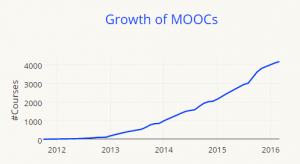A MOOC is a Massive Open Online Course aiming to unlimited participation and open access via the web. The added value of a MOOC, apart being online, free and accessible everywhere is to provide interactive user forums to support community interactions among students, professors, and teaching assistants.
MOOCs have a recent history: introduced at first in 2008 and emerged around 2012. But let’s see some figures.
In 2015 MOOC space essentially doubled. According to data collected by Class Central, the total number of students who signed up for at least one course has crossed 35 million—up from an estimated 16-18 million last year.
Coursera, the largest online course provider in the world (MOOC or otherwise), added 7 million new students to its userbase (and so it now has 17 million students in total). Coursera, edX, and Udacity are normally known as the big three. FutureLearn, which closed 2015 on a high, had a breakout year, and it now has more students than Udacity; this makes FutureLearn the third largest MOOC provider in the world now. They grew 275% in 2015 and are rapidly approaching the three million user mark.

Currently there are 100+ Specializations, Nanodegrees, and XSeries credentials, most of which were created in 2015, and we can expect that number to more than double in 2016. The projections for 2017 and beyond could be exponential.
Although trends showed a growing interest, MOOCs recently have been questioned. An article from the recent release of the Proceedings from the 2016 Conference of the Human Computer Interaction (HCI) Society of Korea, that took place last January, brings new evidence to the table. From a Universal Design for Learning (UDL) standpoint, it evaluates popular MOOC platforms (Coursera, edX and Khan) to find barriers to openness.
According to Forbes despite this apparent need for a more flexible, affordable and on-going approach to learning, platforms such as MOOCs have thus far failed to “cross the chasm” into the mainstream. Most courses are taken by those already beholden of a degree, and there is a strong sense that HR departments are failing to capitalize on the courses available to ensure that employees are constantly learning and developing their skills. Indeed, a recent survey found that just one in four HR and learning and development professionals formed an established part of the training on offer to employees.
Open education yet is the core element of EU policy in the framework of lifelong learning. Opening up Education (initiative launched in 2013) is based on the concept of innovative teaching and learning for all through new technologies and open educational resources. It also produced the creation of a portal “Open Education Europa” , which offers access to all existing European Open Educational Resources in different languages in order to be able to present them to learners, teachers and researchers.
